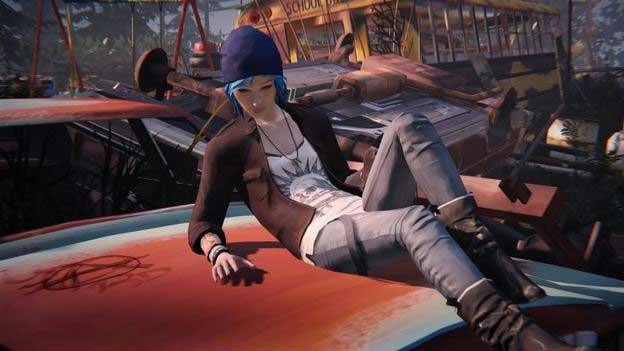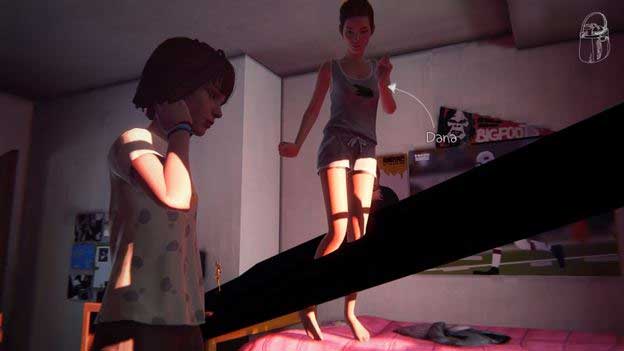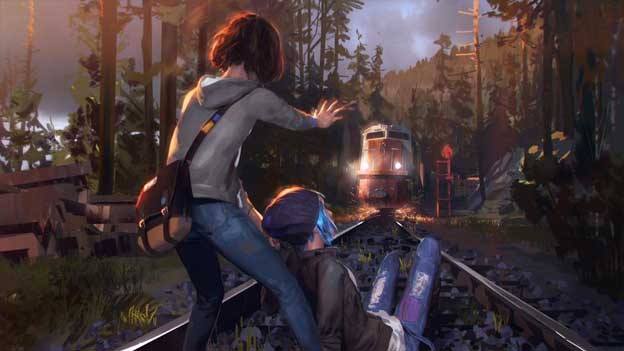Innovative and Flawed
It is often said that our most innovative endeavors are also our most flawed. From the N64 analog stick to Sega’s early experiments with digital distribution, firsts are usually not bests. Yet without them, the path would never be opened up for followers who would later refine these experiments and make them commonplace.
This is the best way I can describe Life is Strange and its most recent episode, Out of Time . It has the guts to deal with some very serious issues like date rape, suicide, domestic violence, drug abuse, and other issues that many games won’t even begin to touch. However, in its quest to spin a compelling and devastatingly serious narrative the likes of which we haven’t yet seen in the gaming industry, Life is Strange trips over itself by making some simple and sometimes unforgivable gameplay mistakes. As a result, we routinely find ourselves roadblocked with busywork and strangely disjointed conversations on our way to getting to the narrative high points of this interesting indie movie-style point and click time rewinding adventure.
Lots of things carry over from the first episode. The decent graphics but somewhat stiff animations are the same. The amazing soundtrack and voice work are the same. Even the control scheme is the same, which is to say you are far better off playing this on a controller than with a keyboard and mouse.
Unfortunately, many of the flaws in the formula carry over as well. The game still tells you an objective, but doesn’t expect you to complete it right away. Instead, it expects you to ignore your objective and instead wander around talking to everyone and examining everything. You are actively punished if you do not seek out this extra info by missing out on choices and actions that can have impact on the story. I wouldn’t mind if, say, there was some downside to wandering around, like being late to your meet-ups or whatnot, but instead the only real choice is whether to experience all the game’s content or not.
Episode 2 continues to be really bad about telling you what it actually wants you to do at any given point. You end up just futzing around clicking on stuff until you get it “right.” Heck, I didn’t even know I could take pictures as collectibles until this episode, and apparently that’s one of the main collectibles in the game.

The game also still forces you into making decisions with no good outcome. It’s clear now that the ramifications of these decisions will become more apparent in later episodes, as your decisions from episode one come back to bite you, but for now it just feels like you are just backed into a corner over and over again.
Now these flaws are joined by another ugly monster of game design: padding. There is so much of this game that could just be cut out without effecting the story in any way whatsoever. For example, before you leave your room in the beginning of the game, you have to get dressed. The game could have dressed you automatically in a cutscene or something, but instead you have to walk to your closet, click on your clothes, get dressed, and then leave the room. You cannot leave the room until you do this, so choosing to not get dressed has absolutely no bearing on the story. It’s just a meaningless hurdle you need to jump through in order to continue.

This happens far too often. Before you can leave a diner, you need to drink coffee, then play a game where you “guess” what is in your friend’s pockets by rewinding time, then examine a scene and explain it to your friend moment by moment, and then you can finally leave. If you choose the wrong option even once during these segments, your friend totally disbelieves in your super power and you have to play the scene all over again, which takes forever. Similarly, later in the game you have to find five bottles for your friend to shoot ’cause she is just such a rowdy wild girl. You are in a junkyard filled with cans, jugs, and all manner of things to use for target practice, but unless you find five very specific green bottles, the game won’t let you proceed. I’m not playing this game to experience Bottle Finder 3000 , and considering these bottles barely play into the plot, the whole segment could have been cut and saved you 30 minutes to an hour of stupid random searching.
But once you get past all this, you get participate in the most fun activity the game has to offer: being a high-school girl. You weave this tangled web of relationships as you learn everyone’s secrets and slowly make new friends. Whenever the game is focusing on the people you know, it becomes enthralling. You want to know what the popular girls are planning. You want to know how your best friend is dealing with her broken home.
You especially want to know about Kate Marsh, the quiet religious girl who seems to be going through some tough times. Kate is the one character that the episode most focuses on, and her plot threads encompass the aforementioned date rape and suicide. If you were able to rewind time again and again in an attempt to fix the serious problems that Kate is going through, that would cheapen the entire experience. Instead, Life is Strange makes the bold move of taking your powers away. One of the subplots of the game is that Max, our main character, can’t fully control her power. Using it is harming her somehow and overuse makes it burn out for periods of time. So at some crucial moments when rewinding time would just be too convenient, Max can’t do so. This choice to take your power away doesn’t feel frustrating, rather, it makes you feel profoundly vulnerable, which is exactly what the scenes call for.
It’s this mastery of tone that really makes Life is Strange stand out above other games of its ilk. The camera work is phenomenal, with interesting pulled out angles making you feel like you are being watched during conversations. It still shows great control of its musical score, fading it in at the right points to punctuate the emotional feeling of any particular scene. The characters feel complex and your fellow teenagers feel cruel in a very real way, which makes them perhaps more terrifying than any other diabolical video game villain.
It’s also worth noting that the game has a real devotion to making your choices matter, far more than most Telltale games in a similar format. There are simply pieces of content in this episode you cannot see if you didn’t make certain choices in the last episode. Whole parts of the game are cut off every time you make a decision, and even though you are trying to make things work out for the best, you’ll likely not get the outcome you really want. Of course, this just gives you more reason to play again. It also puts Episode One in a far better context. I have a feeling that Life is Strange will be at its best when you can play all the episodes at once.

Despite that general high quality, there are a few flaws in the narrative and decision-making aspects of the game. The Vortex Club, a society of rich kids, simply seems far too powerful to be believable. The rich kids themselves are also too powerful, holding principals and cops in their hands easily, stealing your personal info, vandalizing your room, and making death threats with no consequences. The most tense points in the game come out of left field, with characters randomly showing up, or worse, having these odd emotional swings where they go from your best friend to an annoyed enemy with little provocation.
Still, this game sold itself to me as a must play when I reached the final screen, after the climax, and after the credits. It was just a simple and powerful message that gave you info for support groups if you are dealing with depression, suicidal tendencies, or any other issue that the game has tackled. That, is where it is really innovating. Life is Strange has a connection to real life that few other games do. It doesn’t only seek to let you empathize with teenagers who may be experiencing this right now, but also gives you the resources you need to help yourself or your loved ones should you need it. It wants to make your life better, and that is a noble cause, even if it comes from a somewhat flawed game.
Episode Two of Life is Strange really hooked me. I still want to know more about this world. I want to know why Max has her powers. I want to know why teenage girls are mysteriously disappearing. I want to know how the rich kids’ families destroyed the town. I want to know how Max could possibly save the town from the impending tornado she keeps having visions of. I want to know more, because the game tugged at my heart strings, even though it simultaneously pressed my anger buttons. I supposed I could deal with a couple more hours of Bottle Finder 3000 if it means I get to see what happens next.
RATING OUT OF 5 RATING DESCRIPTION 4.0 Graphics
The graphics haven’t changed, and still serve the story well. 3.5 Control
KBAM controls continue to infuriate, but controllers work just fine. 4.9 Music / Sound FX / Voice Acting
The music is likely the most excellent thing the game has to offer. 4.0 Play Value
The story is compelling if you can get past the bouts of Bottle Finder 3000. 3.9 Overall Rating – Good
Not an average. See Rating legend below for a final score breakdown.
| Review Rating Legend | |||
|---|---|---|---|
| 0.1 – 1.9 = Avoid | 2.5 – 2.9 = Average | 3.5 – 3.9 = Good | 4.5 – 4.9 = Must Buy |
| 2.0 – 2.4 = Poor | 3.0 – 3.4 = Fair | 4.0 – 4.4 = Great | 5.0 = The Best |
Game Features:
